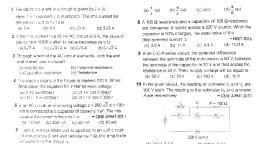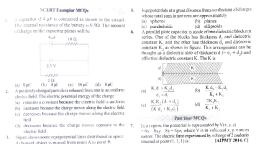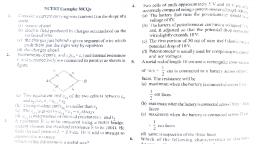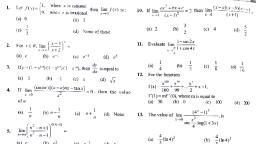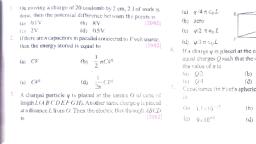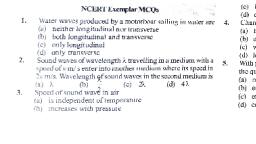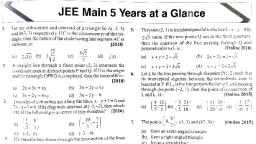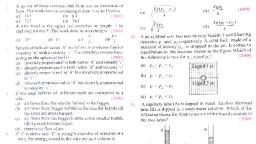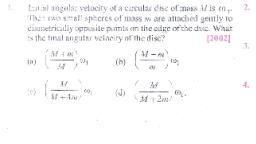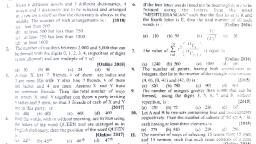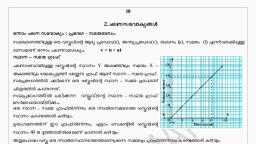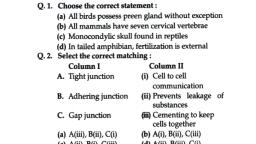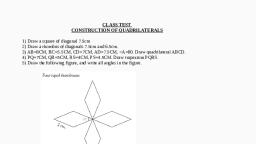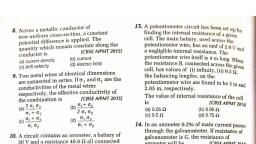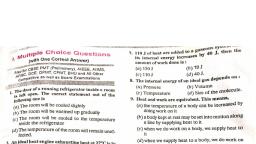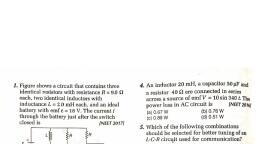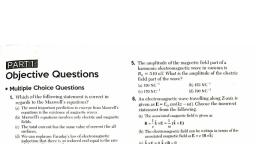Question 1 :
Choose any one of the following four responses.
A. If both Assertion & Reason are True but Reason
is not a correct explanation of the Assertion.
B. If both Assertion & Reason are False.
C. If Assertion is True but the Reason is False.
D. If both Assertion & Reason are True & the
Reason is a correct explanation of the Assertion.
<br>Assertion :-Bulk modulus of elasticity (K) represents incompressibility of the material.
Reason :- Bulk modulus of elasticity is proportional to change in pressure.
Question 2 :
Three blocks of masses {tex} m _ { 1 } , m _ { 2 } {/tex} and {tex} m _ { 3 } {/tex} are connected by a massless strings, as shown, on a frictionless table. They are pulled with a force {tex} T _ { 3 } = 40 \mathrm { N } {/tex}. If {tex} m _ { 1 } = 10 \mathrm { kg } , m _ { 2 } = 6 \mathrm { kg } {/tex} and {tex} m _ { 3 } = 4 \mathrm { kg } {/tex}. The tension {tex} \mathrm { T } _ { 2 } {/tex} will be<br><img style='object-fit:contain' src="https://storage.googleapis.com/teachmint/question_assets/NEET/5f042694eb5b142d10d75deb"><br>
Question 3 :
A junction diode has resistance of 50 ohm when forward biased and 5000 ohm when reverse biased. The current in the arrangement shown in the figure will be <img style='object-fit:contain' src="https://storage.googleapis.com/teachmint/question_assets/NEET/5b045b937f6cca08b9fda8b5">
Question 4 :
<p> Find the magnitude of acceleration of centre of mass of two blocks as shown in figure. Neglect friction everywhere. {tex}(g=10 ms^{-2}){/tex} </p><img style='object-fit:contain' src="https://storage.googleapis.com/teachmint/question_assets/NEET/5b045b937f6cca08b9fda8a8"/>
Question 5 :
Electric field inside a copper wire of length 10 metres, resistance 2 ohm connected to a 10 volt battery is
Question 6 :
Two parallel large thin metal sheets have equal surface charge densities {tex} \left( \sigma = 26.4 \times 10 ^ { - 12 } \mathrm { c } / \mathrm { m } ^ { 2 } \right) {/tex} of opposite signs. The electric field between these sheets is
Question 10 :
The equivalent capacity between A and B in the given circuit is<br><img style='object-fit:contain' src="https://storage.googleapis.com/teachmint/question_assets/NEET/5ae0287c6daa590705ad359f">
Question 11 :
A body is initially at rest. It undergoes one- dimensional motion with constant acceleration. The power delivered to it at time {tex} t {/tex} is proportional to:
Question 12 :
The intensity ratio of the two interfering beams of light is {tex}\beta \frac{I_{max} - I_{min}}{I_{max} + I_{min}}{/tex}
Question 13 :
Let F be the force acting on a particle having position vector r and {tex}\tau{/tex} be the torque of this force about the origin. Then
Question 14 :
A closed spherical surface of radius {tex} \mathrm { R } {/tex} encloses an electric dipole. The net electric flux through the surface is<br><img style='object-fit:contain' src="https://storage.googleapis.com/teachmint/question_assets/NEET/5f0424f7642b9f2cba2cfe65"><br>
Question 16 :
Two capacitors when connected in series have a capacitance of {tex} 3 \mu \mathrm { F } {/tex}, and when connected in parallel have a capacitance of {tex} 16 \mu \mathrm { F } {/tex}. Their individual capacities are
Question 18 :
If yellow light emitted by sodium lamp in Young's double-slit experiment is replaced by the monochromatic blue light of the same intensity
Question 19 :
Thermal capacity of {tex} 40 \mathrm { g } {/tex} of aluminium ( specific heat, {tex} s = 0.2 \mathrm { cal } / \mathrm { g } \mathrm { K } {/tex} ) is
Question 21 :
<p>
A thin lens of material having refractive index µ = 1.5 and focal length of 20 cm in air has two mediums of different refractive indices {tex}\mu_1{/tex}=1.2 and {tex}\mu_2{/tex}=2.5 covering upper and lower halves of the lens, respectively as shown in figure. If an object is placed on the principal axis, then its two images will be formed one after refraction from upper part and other after refraction from lower part. Considering the object to be at {tex}\infty{/tex} , the separation between two images formed would be :-
</p>
<img style='object-fit:contain' src="https://storage.googleapis.com/teachmint/question_assets/NEET/5b045b937f6cca08b9fda8ae"/>
Question 22 :
A particle executes linear simple harmonic motion with an amplitude of 3 cm. When the particle is at 2 cm from the mean position, the magnitude of its velocity is equal to that of its acceleration. Then its time period in seconds is :-
Question 23 :
A particle of mass m moves along a circular path of radius r with a centripetal acceleration {tex}a_n{/tex} changing with time t as {tex}a_n=kt^2{/tex} , where k is a positive constant. The average power developed by all the forces acting on the particle during the first {tex}t_0{/tex} seconds is
Question 24 :
Consider two thin identical conducting wires covered with very thin insulating material. One of the wires is bent into a loop and produces magnetic field {tex} B _ { 1 } , {/tex} at its centre when a current I passes through it. The ratio {tex} B _ { 1 }: B _ { 2 } {/tex} is:
Question 25 :
If {tex} \mathrm { c } , {/tex} the velocity of light, {tex} \mathrm { g } {/tex} the acceleration due to gravity and {tex} \mathrm { P } {/tex} the atmospheric pressure be the fundamental quantities in MKS system, then the dimensions of length will be same as that of
Question 26 :
The escape velocity for a body projected vertically upwards from the surface of earth is 11 {tex} \mathrm { km } / \mathrm { s } {/tex}. If the body is projected at an angle of {tex} 45 ^ { \circ } {/tex} with the vertical, the escape velocity will be
Question 27 :
The graph of an object's motion (along the {tex} x {/tex} - axis) is shown in the figure. The instantaneous velocity of the object at points {tex} A {/tex} and {tex} B {/tex} are {tex} v _ { A } {/tex} and {tex} v _ { B } {/tex} respectively. Then<br><img style='object-fit:contain' src="https://storage.googleapis.com/teachmint/question_assets/NEET/5f04269beb5b142d10d75dfc"><br>
Question 28 :
Figure shows a simple potentiometer circuit for measuring a small e.m.f. produced by a themocouple. The meter wire PQ has a resistance {tex}5\Omega{/tex} and the driver cell has an e.m.f. of 2V. If a balance point is obtained 0.600 m along PQ when measuring an e.m.f. of 6.00 mV, what is the value of resistance R:- <img style='object-fit:contain' src="https://storage.googleapis.com/teachmint/question_assets/NEET/5b02ced57f6cca08b9fd9b56">
Question 29 :
A rectangular loop with a sliding connector of length {tex}\ell{/tex}= 1.0 m is situated in a uniform magnetic field B = 2T perpendicular to the plane of loop. Resistance of connector is (r) 2{tex}\Omega{/tex} . Two resistors of 6{tex}\Omega{/tex}and 3{tex}\Omega{/tex} are connected as shown in figure. The external force required to keep the connector moving with a constant velocity v = 2 m/s is <img style='object-fit:contain' src="https://storage.googleapis.com/teachmint/question_assets/NEET/5b02ced57f6cca08b9fd9b5e">
Question 30 :
A satellite of mass {tex} m {/tex} is circulating around the earth with constant angular velocity. If radius of the orbit is {tex} R _ { 0 } {/tex} and mass of the earth {tex} M {/tex}., the ratio of angular momentum of the satellite about the centre of the earth and its kinetic energy will be:
Question 31 :
A circular disc {tex} \mathrm {A} {/tex} of radius {tex} \mathrm {r} {/tex} is made from an iron plate of thickness {tex} \mathrm {t} {/tex} and another circular disc {tex} \mathrm {B} {/tex} of radius {tex} \mathrm {4r} {/tex} is made from an iron plate of thickness {tex} \mathrm {t/4} {/tex}. The relation between the moments of inertia {tex} \mathrm { I } _ { \mathrm { A } } {/tex} and {tex} \mathrm { I } _ { \mathrm { B } } {/tex} is
Question 32 :
For the transistor circuit shown below, if {tex}\beta{/tex} = 100, voltage drop between emitter and base is 0.7 V then value of {tex}V_{CE}{/tex} will be :- <img style='object-fit:contain' src="https://storage.googleapis.com/teachmint/question_assets/NEET/5b02ced57f6cca08b9fd9b52">
Question 33 :
A particle of a mass M is placed at the centre of a uniform spherical shell of equal mass and radius a. The gravitational potential at a point P at a distance a/2 from the centre.
Question 34 :
In the circuit shown in fig. {tex}C_1= 6\mu F{/tex}, {tex}C_2= 3\mu F{/tex} and battery B = 20V. The switch {tex}S_1{/tex} is first closed. It is then opened and {tex}S_2{/tex} is closed. What is the final charge on {tex}C_2{/tex}? <img style='object-fit:contain' src="https://storage.googleapis.com/teachmint/question_assets/NEET/5b045b937f6cca08b9fda89f">
Question 35 :
The oscillating electric and magnetic field vectors of electromagnetic wave are oriented along
Question 36 :
The de-Broglie wavelength of the electron in the ground state of the hydrogen atom is of the first orbit of hydrogen atom {tex} = 0.53 Å {/tex} ) :<br>
Question 37 :
The ratio of wavelengths of the last line of Balmer series and the last line of Lyman series is :-
Question 38 :
In an astronomical telescope in normal adjustment a straight black line of length {tex} \mathrm {L}{/tex} is drawn on inside part of objective lens. The eye-piece forms a real image of this line. The length of this image is {tex} \mathrm {I}{/tex}. The magnification of the telescope is :<br>
Question 39 :
Five forces {tex} \overrightarrow { \mathrm { F } } _ { 1 } , \overrightarrow { \mathrm { F } } _ { 2 } , \overrightarrow { \mathrm { F } } _ { 3 } , \overrightarrow { \mathrm { F } } _ { 4 } {/tex} and {tex} \overrightarrow { \mathrm { F } } _ { 5 } {/tex} are acting on a particle of mass {tex} 2 \mathrm { kg } {/tex} so that it is moving with 4 {tex} \mathrm { m } / \mathrm { s } ^ { 2 } {/tex} in east direction. If {tex} \overrightarrow { \mathrm { F } } _ { 1 } {/tex} force is removed, then the acceleration becomes {tex} 7 \mathrm { m } / \mathrm { s } ^ { 2 } {/tex} in north then the acceleration of the block if only {tex} \overrightarrow { \mathrm { F } } _ { 1 } {/tex} is acting will be :
Question 40 :
The total length of a sonometer wire between fixed ends is {tex} 110 \mathrm { cm } . {/tex} Two bridges are placed to divide the length of wire in ratio {tex} 6: 3: 2 . {/tex} The tension in the wire is {tex} 400 \mathrm { N } {/tex} and the mass per unit length is {tex} 0.01 \mathrm { kg } / \mathrm { m } {/tex}. What is the minimum common frequency with which three parts can vibrate?
Question 41 :
The velocity of the liquid coming out of a small hole of a large vessel containing two different liquids of densities {tex}2\rho{/tex} and {tex}\rho{/tex} as shown in figure is <img style='object-fit:contain' src="https://storage.googleapis.com/teachmint/question_assets/NEET/5b02ced57f6cca08b9fd9b4e">
Question 42 :
In the figure shown, ABC is a uniform wire. If centre of mass of wire lies vertically below point {tex} \mathrm { A } , {/tex} then {tex} \frac { \mathrm { BC } } { \mathrm { AB } } {/tex} is close to :<br><img style='object-fit:contain' src="https://storage.googleapis.com/teachmint/question_assets/NEET/5f04375e6f98e50a19b4a113"><br>
Question 43 :
A hemispherical glass body of radius {tex} 10 \mathrm { cm } {/tex} and refractive index 1.5 is silvered on its curved surface. A small air bubble is {tex} 6 \mathrm { cm } {/tex} below the flat surface inside it along the axis. The position of the image of the air bubble made by the mirror is seen:<br><img style='object-fit:contain' src="https://storage.googleapis.com/teachmint/question_assets/NEET/5f0437846f98e50a19b4a11d"><br>
Question 44 :
A proton and an {tex} \alpha {/tex} -particle enter a uniform magnetic field perpendicularly with the same speed. If proton takes {tex} 25 \mu {/tex} second to make 5 revolutions, then the time period for the {tex} \alpha {/tex} -particle would be
Question 45 :
The x and y coordinates of the particle at any time are x = 5t-2t<sup>2</sup> and y = 10t respectively, where x and y are in meters and t in seconds. The acceleration of the particle at t = 2s is

